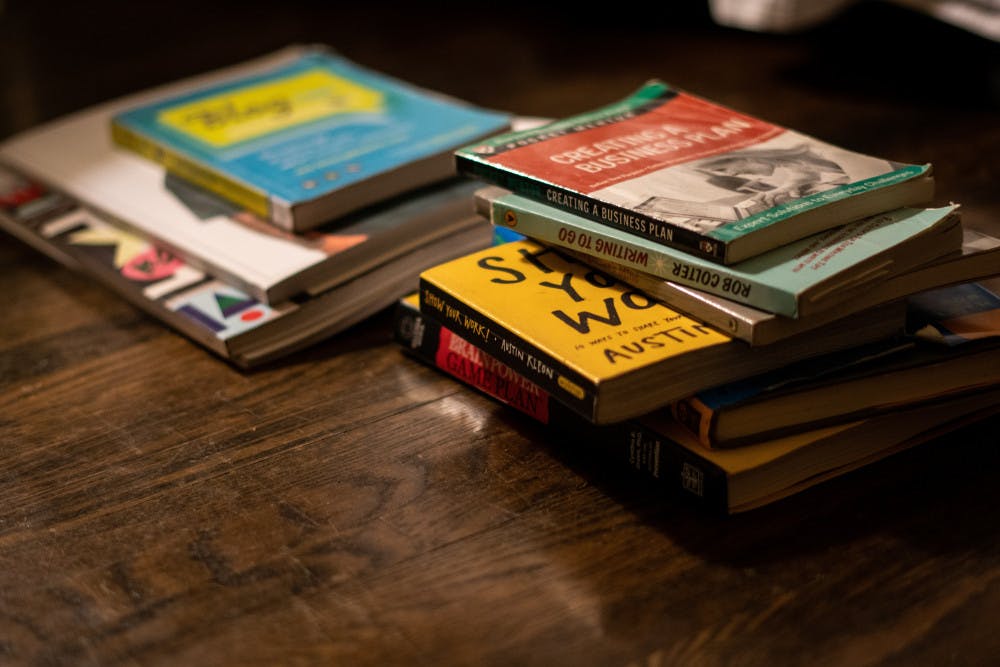Tuition. Rent. Food. School Supplies. Gas. Parking decals. If you’re a student, you’ve probably had to pay for some, if not all, of these expenses before you started your first day at school. And just when you think your bank account is done playing limbo, your professor says those dreaded four words: “The textbook is mandatory.”
At the UF, the average estimated cost for books and supplies is $1,210. While that number doesn’t lay out how much money solely goes toward books, the average cost of textbooks for a freshman undergrad at a 4-year public university in America from 2003 to 2004 was $898.00, according to the Government Accountability Office. If you count the average student as full time with 12 to 16 credits with a single textbook for each three/four credit class, the price of each textbook can range from around $180 to $220. That’s more expensive than a first edition of Ernest Hemingway’s “Men Without Women.”While we may learn a lot of valuable information from these textbooks, it doesn’t justify the price being higher than that of a vintage American classic novel.
So, why are textbooks so pricey? They weren’t always that way. The Bureau of Labor Statistics reports that prices of college brand-new print textbooks have increased 88 percent from 2006 to 2016. Textbooks come in various forms, and can be bought digitally, bought used or rented. Purchasing an online version of a book can sometimes be less expensive than purchasing a physical copy, but then you’re stuck with an extremely overpriced, hard-to-navigate PDF.
Part of what makes a textbook cost so much is the bookstore markup that adds an additional cost when you purchase through a campus bookstore. Even though campus bookstores tend to buy books with a discount, they typically sell them to students at a 25 to 28 percent markup. Those costs may be covering the maintenance of the store, but 25 percent of every textbook purchased by students seems extreme.
Production cost of the average textbook is 5 percent. The author will typically see 15 percent of the money made from textbooks, while editorial workers like publishers gain 32 percent. Marketing costs take up to 15 percent, which goes towards things like book fairs, paying field sales representatives, and the cost of free copies given to authors and professors. One percent of the textbook money goes toward transporting the books and making sure they get to their destination safely. Ten percent of the costs go toward general overhead that goes toward utilities and general office expenses. The remaining 22 percent becomes profit for the seller.
The demographic of broke college students doesn’t seem to be a worry to textbook publishers, and overtime the prices seem to escalate without probable cause. While selling textbooks after no longer useful to you is an option, breaking even on a textbook is almost never possible, so you end up selling your barely used book for way less than what you paid for it. Reselling your textbook to the campus bookstore is the equivalent to trying to resell your old Nintendogs game to GameStop and getting offered $2.
Lucky deserved more. You deserve more.
The worst feeling is when you buy a shiny new textbook for class, thinking it would be used. But instead, it gathers dust, and the cashier at the bookstore turns you away when you try to return it. It’s understandable, a book out of its plastic could be seen as unsuitable for reselling. But most of all, it’s heartbreaking and wallet-draining. The seemingly least expensive way to purchase a textbook is to speak to your professor and make sure the textbook will be used in your class. If it’s mandatory, search the ISBN on sites like Amazon and Chegg for the cheapest option.
You might not be able to judge a book by its cover, but you can certainly gawk at the price.
Amanda Martinez is a senior telecommunication major. Her column usually appears on Tuesdays.
Photo by Glen Anthony on Unsplash






